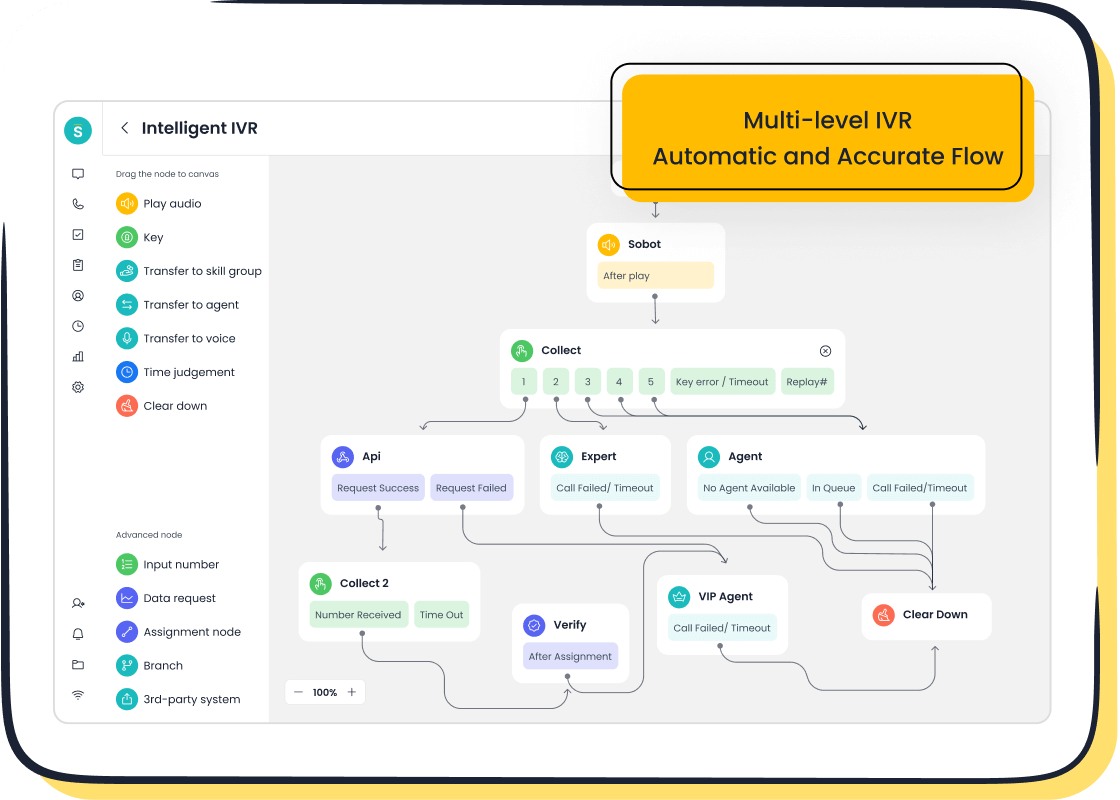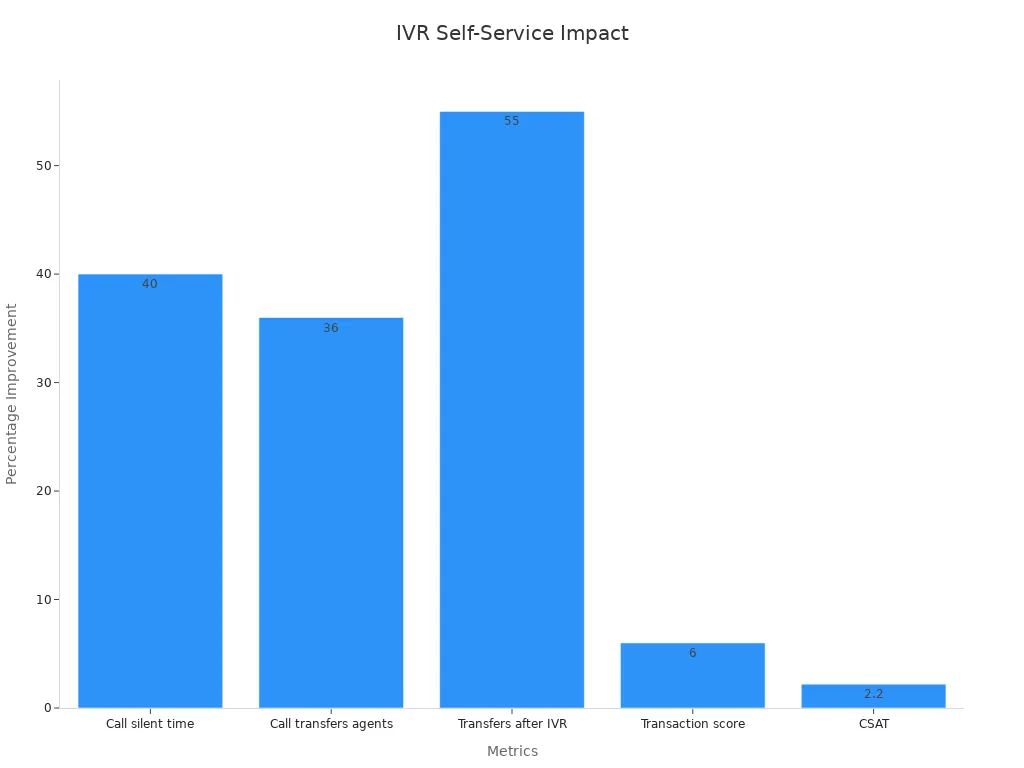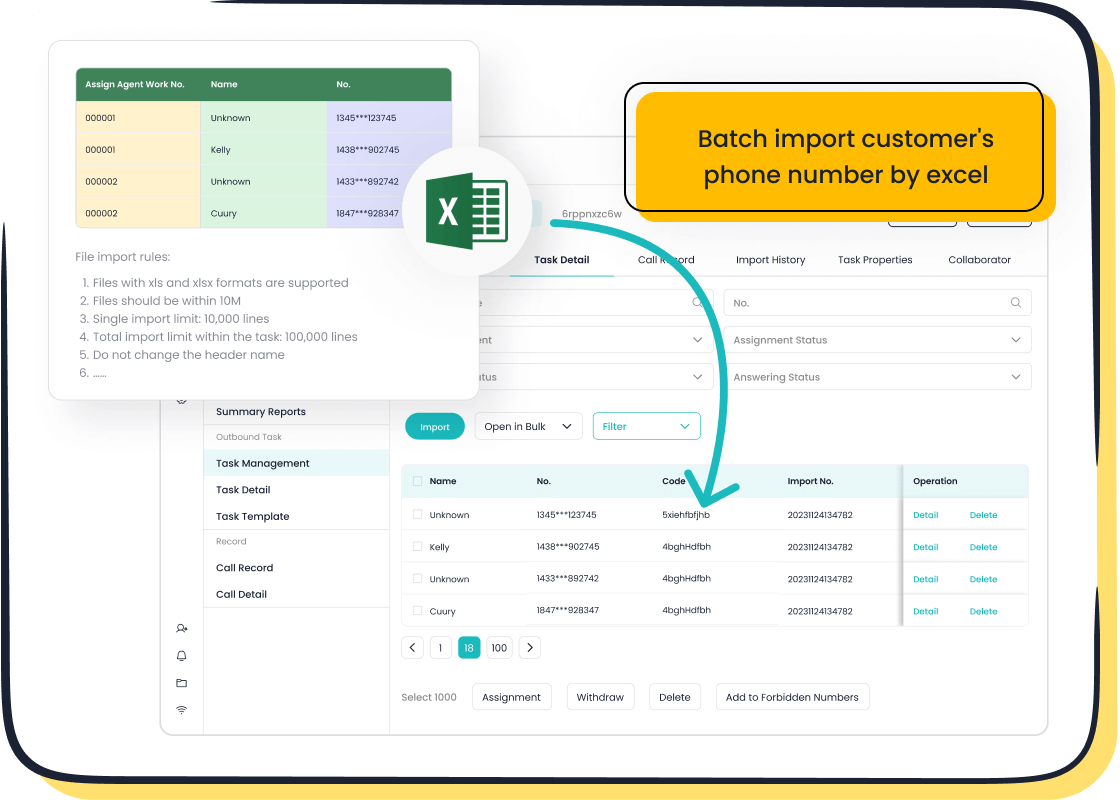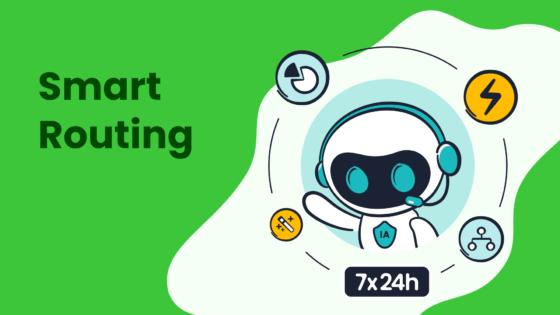What Are the Core Features of IVR Solutions for Call Centers

Interactive Voice Response (IVR) systems have transformed the way call centers operate. These systems automate processes, allowing you to handle customer inquiries more efficiently. By integrating advanced features like intelligent call routing and self-service menus, IVR solutions enhance the customer experience and streamline operations. With tools like Sobot's Voice/Call Center, you can deliver tailored solutions that improve customer satisfaction and ensure seamless interactions. This approach enables your call center to meet the expectations of modern customers while boosting overall efficiency.
Understanding Interactive Voice Response (IVR) Systems
What Is an IVR System
An interactive voice response system is a technology that allows callers to interact with a computerized menu using their voice or keypad inputs. It automates call handling by guiding customers through pre-recorded options, enabling them to resolve issues or reach the right department without human assistance. Businesses use IVR systems to streamline operations and improve customer service. The global IVR market is growing rapidly, projected to increase from $4.2 billion in 2020 to $6.7 billion by 2026, with a compound annual growth rate (CAGR) of 7.9%. This growth highlights the importance of IVR systems in modern call centers.
How IVR Systems Work in Call Centers
IVR systems operate by integrating with telephony and database systems. When a customer calls, the IVR system greets them with a menu of options. The caller selects an option by speaking or pressing a number on their keypad. The system then processes the input and routes the call to the appropriate agent or provides automated assistance. Metrics like average wait time, call abandonment rate, and first-call resolution help measure the system's performance:
| Metric | Description |
|---|---|
| Average Wait Time | Measures the average time callers spend waiting in the IVR system, impacting customer satisfaction. |
| Call Abandonment Rate | Indicates the percentage of callers who hang up before reaching a resolution, reflecting IVR efficiency. |
| First-Call Resolution | Assesses the percentage of calls resolved on the first interaction, showing IVR effectiveness in handling inquiries. |
| Customer Satisfaction | Evaluates overall customer experience with the IVR system, crucial for assessing its success. |
Common Applications of IVR in Customer Service
IVR systems are widely used across industries to enhance customer service. They automate routine tasks, reducing the workload on agents and cutting operational costs. These systems also provide 24/7 availability, ensuring customers receive assistance anytime. For example:
- Retail: Retailers use IVR surveys during peak seasons to gather feedback and adjust inventory.
- Healthcare: Hospitals conduct patient satisfaction surveys post-discharge to improve care quality.
- Finance: Banks use IVR to collect feedback on digital services, refining customer engagement strategies.
A multinational company reported a 40% reduction in survey costs and a 30% faster data collection turnaround, showcasing the efficiency of IVR systems in customer service.
Core Features of Effective IVR Solutions

Intelligent Call Routing and Queue Management
Efficient call routing is the backbone of any successful IVR system. Intelligent call routing ensures that customer inquiries reach the right agent or department quickly. This feature uses predefined rules, such as customer input, agent availability, or priority levels, to direct calls. For example, a customer selecting "billing" in the IVR menu will be routed to a billing specialist, reducing wait times and improving first-contact resolution rates.
Queue management complements call routing by organizing incoming calls based on urgency or customer value. Advanced systems even allow you to offer callback options, ensuring customers don’t have to wait on hold. Metrics like first-contact resolution and call abandonment rates validate the effectiveness of these systems:
| Performance Metric | Description |
|---|---|
| First Contact Resolution | Measures the percentage of calls resolved on the first interaction. |
| Call Wait Time | Tracks the average time a caller waits before being connected to an agent. |
| Call Abandonment | Indicates the percentage of calls that are hung up before reaching an agent. |
| IVR Transitions | Assesses the effectiveness of the IVR system in guiding callers to the right options. |
Sobot’s Voice/Call Center excels in intelligent call routing. Its smart call routing system uses automatic workflows to connect customers to the right agents, ensuring seamless customer interactions. With a 99.99% SLA uptime, you can rely on its stability to handle high call volumes efficiently.
CRM Integration for Personalized Customer Interactions
Integrating your IVR system with a CRM platform transforms customer interactions into personalized experiences. This feature allows the IVR to access customer data, such as purchase history or previous inquiries, to tailor responses. For instance, when a customer calls about an order, the system can greet them by name and provide updates without requiring additional input.
Modern IVR systems, like Sobot’s Voice/Call Center, leverage CRM integration to deliver conversational IVR experiences. These systems remember user details, such as names or order numbers, creating a human-like interaction. They also utilize advanced speech recognition to understand regional accents, making the system accessible to a broader audience. Key benefits of CRM-integrated IVR systems include:
- Customized responses based on customer data.
- Enhanced accessibility through advanced speech recognition.
- Improved customer satisfaction by reducing repetitive questions.

By integrating with popular CRM platforms, Sobot ensures that your contact center operates efficiently while delivering a personalized touch to every interaction.
Self-Service Options and Automated Menus
Self-service options are a cornerstone of modern IVR systems. These features empower customers to resolve issues independently, such as checking account balances, tracking orders, or resetting passwords. Automated menus guide users through these processes, reducing the need for agent intervention. This not only saves time but also lowers operational costs.
The impact of self-service features is evident in performance metrics. A case study revealed the following improvements after implementing automated self-service options:
| Metric | Result |
|---|---|
| Reduction in call silent time | 40% |
| Reduction in Average Handle Time (AHT) | 20 seconds |
| Decrease in call transfers among agents | 36% |
| Decrease in transfers after IVR interactions | 55% |
| FTE reduction on QA processes | 3.2 FTE |
| Improvement in transaction monitoring score | 6% |
| Improvement in Customer Satisfaction (CSAT) | 2.2% |

Sobot’s IVR solution offers robust self-service features, including multilingual support and automated menus. These tools ensure that your customers can access assistance anytime, anywhere, enhancing their overall experience. By reducing agent workload, you can focus on more complex customer needs, boosting productivity across your contact center.
Analytics and Reporting for Performance Insights
Analytics and reporting are essential features of interactive voice response systems. They provide valuable insights into customer interactions, helping you optimize workflows and improve service quality. By analyzing call data, you can identify patterns, measure performance, and make informed decisions to enhance your IVR system's effectiveness.
Key metrics like call containment rate and average handling time reveal how well your IVR system performs. For example, a high call containment rate indicates that customers can resolve issues independently, reducing the need for live agents. Similarly, tracking the customer effort score helps you understand how easy it is for callers to navigate your system. These insights allow you to refine your IVR menus and improve user experience.
| Metric | Description |
|---|---|
| Call containment rate | Measures the percentage of callers who resolve their issues without needing help from a live agent. |
| Average handling time | The average time a caller spends within the IVR system, indicating ease of navigation. |
| Customer satisfaction | Reflects how satisfied callers are with their IVR interactions, indicating effectiveness. |
| First call resolution | Measures the percentage of queries resolved during the first call, indicating promptness and clarity. |
| Call abandonment rate | The percentage of callers who hang up before their issue is resolved, indicating potential issues. |
| Speech analysis | Assesses how well the IVR system interprets human speech, providing insights into user experience. |
| Path analysis | Tracks the routes callers take within the IVR, identifying drop-off points and improving flow. |
| Customer effort score | Indicates how easy it is for callers to navigate the IVR system, reflecting overall user experience. |

Sobot’s Voice/Call Center leverages advanced analytics to monitor call data in real time. Its reporting tools help you track metrics like call abandonment rates and first-call resolution, ensuring your IVR system operates efficiently. With features like speech analysis and path tracking, you can pinpoint areas for improvement and deliver a seamless customer experience.
Multi-Language and Accessibility Features
Multi-language and accessibility features ensure your IVR system caters to a diverse audience. These features allow you to provide support in multiple languages, making your services accessible to customers worldwide. For example, a retail company serving international markets can use a multilingual IVR system to assist customers in their native language, enhancing satisfaction and loyalty.
Accessibility features, such as voice recognition and text-to-speech capabilities, make your IVR system user-friendly for individuals with disabilities. These tools ensure that all customers, regardless of their physical or linguistic limitations, can interact with your system effortlessly.

Sobot’s IVR solution excels in this area. It offers multilingual support, enabling you to customize templates for different languages. Its advanced voice recognition technology adapts to regional accents, ensuring accurate responses. By integrating accessibility features, Sobot helps you create an inclusive customer experience that meets the needs of a global audience.
How IVR Features Improve Customer Satisfaction and Call Center Efficiency
Reducing Wait Times with Smart Call Routing
Smart call routing is a game-changer for reducing wait times in call center IVR systems. This feature ensures that customer inquiries are directed to the most suitable agent or department based on predefined rules like agent availability, customer input, or priority levels. By connecting customers to the right resource quickly, you can significantly enhance their experience and improve customer satisfaction.
Companies that have implemented intelligent call routing report impressive results:
- Call durations have decreased by 30-40 seconds.
- Wait times have been reduced by 25-35%.
- Average handling time has dropped by up to 2 minutes.
These improvements not only save time for your customers but also boost the efficiency of your contact center. Sobot’s Voice/Call Center excels in this area with its smart call routing system. It uses automatic workflows to ensure seamless customer interactions, even during peak hours. With a 99.99% SLA uptime, you can rely on its stability to handle high call volumes without compromising service quality.
Enhancing Customer Experience Through Personalization
Personalization is a cornerstone of modern IVR solutions. By integrating your IVR system with a CRM platform, you can access customer data like purchase history or previous interactions. This allows you to tailor responses and create a more engaging customer experience. For example, when a customer calls about an order, the system can greet them by name and provide updates without requiring additional input.
Modern interactive voice response systems can handle 60-80% of routine inquiries without agent intervention. This leads to a 30-40% reduction in operational costs while maintaining high customer satisfaction. Additionally, organizations using conversational IVR solutions report:
- A 15-25% increase in customer satisfaction scores.
- A 25-35% improvement in first-call resolution rates.

Sobot’s IVR solution takes personalization to the next level. It leverages CRM integration and advanced speech recognition to deliver conversational IVR experiences. These features ensure that your customers feel valued and understood, driving satisfaction and loyalty.
Automating Routine Tasks to Boost Agent Productivity
Automating routine tasks through self-service options and automated menus is one of the most impactful features of IVR systems. These tools empower customers to resolve common issues like checking account balances or tracking orders without agent assistance. This not only enhances the customer experience but also frees up your agents to focus on more complex inquiries.
The productivity boost from automation is well-documented:
| Performance Indicator | Description |
|---|---|
| Overall call resolution rate | Measures the percentage of calls resolved on the first attempt versus total calls. |
| Call abandonment rate | Calculated as the number of abandoned calls divided by total incoming calls, expressed as a percentage. |
| Average handle time (AHT) | Evaluates the average duration of calls, indicating efficiency and potential training needs for agents. |

Sobot’s Voice/Call Center offers robust self-service options, including multilingual support and automated menus. These features reduce agent workload and improve operational efficiency. By automating repetitive tasks, you can optimize resource allocation and ensure your team focuses on delivering exceptional customer support.
Providing 24/7 Support for Customer Convenience
Offering 24/7 support is a vital feature of modern IVR systems. It ensures that your customers can access assistance at any time, regardless of their location or time zone. This round-the-clock availability enhances customer satisfaction by providing immediate help when it’s needed most. Whether it’s a late-night inquiry or an urgent issue during a holiday, your IVR system can handle it without delays.
One of the key advantages of 24/7 support is its ability to address common customer needs through self-service options. For example, customers can use automated menus to check order statuses, reset passwords, or retrieve account details without waiting for an agent. This not only saves time for your customers but also reduces the workload on your support team. A well-designed IVR system can resolve up to 60% of routine inquiries independently, allowing your agents to focus on more complex issues.
Another benefit of 24/7 support is its impact on global businesses. If your company serves customers across different time zones, a multilingual IVR system ensures that everyone receives the same level of service. For instance, Sobot’s Voice/Call Center offers multilingual templates and time zone support, making it easier for you to provide consistent customer support worldwide. These features help you build trust and loyalty among your diverse customer base.
Additionally, 24/7 support improves operational efficiency by reducing call abandonment rates. Customers are less likely to hang up when they know they can get help immediately. This leads to higher satisfaction levels and better overall resolution rates. For example, a retail company using a 24/7 IVR system reported a 20% decrease in call abandonment and a 15% improvement in first-call resolution. These metrics highlight the importance of continuous availability in meeting customer expectations.
By implementing a robust IVR system like Sobot’s, you can ensure that your customers always have access to the support they need. This not only enhances their experience but also strengthens your brand’s reputation as a reliable service provider.
Best Practices for Implementing IVR Systems
Designing User-Friendly Menus and Workflows
Creating user-friendly IVR menus and workflows is essential for delivering a seamless customer experience. A well-designed menu minimizes confusion and helps customers quickly find the assistance they need. Studies like Hick's Law: Designing Long Menu Lists reveal that fewer choices reduce decision time, making navigation easier. To achieve this, you should limit menu options to five or fewer per level and use clear, concise language.
AI-enhanced IVR systems can further streamline workflows. For example, the study Streamlining Telecom Customer Support with AI-Enhanced IVR and Chat highlights how AI-driven systems improve efficiency and reduce call handling times. Sobot’s Voice/Call Center offers a drag-and-drop interface for building intuitive menus. This feature allows you to customize workflows in real-time, ensuring your contact center adapts to changing customer needs.
| Study Title | Key Findings |
|---|---|
| Hick's Law: Designing Long Menu Lists | More choices lead to longer decision times; combining with design techniques enhances usability. |
| Streamlining Telecom Customer Support with AI-Enhanced IVR and Chat | AI-driven IVR systems improve efficiency, reduce call handling times, and enhance customer satisfaction. |
Integrating IVR with Existing Systems Like Sobot's Voice/Call Center
Integrating your IVR system with existing platforms, such as CRMs or help desks, enhances operational efficiency. This integration allows your IVR to access customer data, enabling personalized interactions. For instance, when a customer calls, the system can retrieve their purchase history and provide tailored responses.
Sobot’s Voice/Call Center excels in integration, offering seamless compatibility with popular CRMs. This feature improves customer retention rates and streamlines business communications. Additionally, it provides 24/7 accessibility, ensuring your contact center remains operational around the clock. Customized greetings further enhance customer satisfaction, making your service feel more personal.
- Integration of IVR systems can enhance customer satisfaction.
- Improved customer retention rates are noted with the use of IVR.
- Streamlined business communications lead to better operational efficiency.
- IVR systems provide 24/7 accessibility for customer support.
- Customized greetings can further boost customer satisfaction.
Regularly Monitoring and Optimizing IVR Performance
Continuous monitoring and optimization ensure your IVR system remains effective. Regular check-ins help identify challenges and foster open communication among your team. Performance metrics like call containment rate and caller satisfaction provide actionable insights. For example, a high call containment rate indicates that customers resolve issues without agent assistance, reducing operational costs.

Sobot’s Voice/Call Center includes advanced analytics tools to track these metrics in real-time. By analyzing data such as abandonment rates and customer effort scores, you can refine your IVR workflows. This proactive approach improves both customer satisfaction and contact center efficiency.
| Evidence Type | Description |
|---|---|
| Regular Check-ins | Schedule regular meetings to review progress, discuss challenges, and foster open communication. |
| Utilize Performance Metrics | Implement KPIs to track progress objectively and identify areas for improvement. |
Key metrics to monitor include:
- Call Containment Rate: Measures how many issues are resolved through IVR without live agents.
- Caller Satisfaction: Gauged through post-call surveys to identify improvement areas.
- Abandonment Rates: Analyzes when callers disconnect, indicating potential issues with the IVR system.
Training Agents to Support and Leverage IVR Features
Training your agents to effectively use IVR features is essential for maximizing the system's potential. Well-trained agents can seamlessly collaborate with the IVR system, ensuring smoother customer interactions and higher satisfaction rates. Here’s how you can prepare your team:
1. Provide Comprehensive Training on IVR Functions
Equip your agents with a thorough understanding of the IVR system. Explain how it works, its key features, and how it integrates with other tools like CRM platforms. Use hands-on training sessions to familiarize them with the system's interface and workflows. For example, Sobot’s Voice/Call Center offers a drag-and-drop IVR builder, which agents can learn to customize for specific scenarios.
2. Teach Agents to Handle Escalations
Not all customer issues can be resolved through IVR. Train your agents to handle escalations effectively when calls are transferred to them. Encourage them to review the IVR interaction history before engaging with the customer. This approach saves time and ensures a personalized experience.
3. Focus on Communication Skills
Strong communication skills are vital for agents working alongside IVR systems. Teach them to use clear and empathetic language when assisting customers. This is especially important when resolving issues that the IVR couldn’t address.
Tip: Role-playing exercises can help agents practice real-life scenarios where they interact with customers after an IVR transfer.
4. Monitor and Provide Feedback
Regularly monitor agent performance to identify areas for improvement. Use analytics from the IVR system, such as call resolution rates and customer satisfaction scores, to provide constructive feedback. This continuous learning process helps agents adapt to evolving customer needs.
By investing in agent training, you ensure that your IVR system operates at its full potential. A well-prepared team not only enhances customer satisfaction but also boosts overall call center efficiency.
Future Trends in IVR Technology

AI-Powered IVR Systems for Enhanced Interactions
Artificial intelligence is revolutionizing interactive voice response systems, making them smarter and more intuitive. AI-powered IVR systems leverage natural language processing (NLP) and machine learning to understand customer intent better. This allows them to handle complex queries and provide accurate responses without human intervention. For example, companies like Telefónica and Swisscom have implemented AI-driven IVR solutions, resulting in improved customer engagement and operational efficiency. Telefónica’s Teneo solution enhanced omnichannel support, while Swisscom’s conversational voice system boosted sales and reduced costs.
These advancements enable IVR systems to adapt dynamically to customer needs. Instead of static menus, AI-powered systems offer personalized interactions, improving the overall customer experience. Sobot’s Voice/Call Center incorporates AI capabilities, such as an AI-powered voicebot, to deliver intelligent and efficient customer interactions. By adopting these technologies, your contact center can reduce wait times, enhance satisfaction, and optimize resource allocation.
Voice Recognition and Natural Language Processing
Modern IVR systems now feature advanced voice recognition and NLP, enabling customers to interact using natural speech. This eliminates the need for rigid commands, making the experience more user-friendly. These systems can recognize various accents and dialects, ensuring accurate responses for a diverse audience. For instance, NLP algorithms combined with conversational AI allow IVR systems to handle nuanced queries, improving interaction quality.
Sobot’s IVR solution excels in this area by integrating advanced voice recognition technology. It adapts to regional accents and provides multilingual support, ensuring inclusivity. This technology not only enhances the customer experience but also reduces call handling times. As a result, your contact center can operate more efficiently while meeting the needs of a global audience.
Omnichannel Integration for Seamless Customer Support
Omnichannel integration is becoming a cornerstone of IVR technology. It ensures that customers receive consistent service across all touchpoints, whether they interact via phone, email, or social media. This integration reduces the need for customers to repeat information when switching channels, streamlining their journey. Research shows that companies with strong omnichannel engagement retain 89% of their customers, highlighting its importance in building loyalty.
Sobot’s Omnichannel Solution exemplifies this trend by unifying customer interactions across platforms. Its seamless integration with CRM systems ensures that agents have access to complete customer histories, enabling personalized support. By adopting omnichannel IVR solutions, your contact center can deliver a cohesive and efficient customer experience, reducing frustration and boosting satisfaction.
Predictive Analytics for Proactive Customer Service
Predictive analytics transforms how you manage customer service in your contact center. By analyzing historical data, this technology helps you anticipate customer needs and take proactive measures. It enables you to address potential issues before they escalate, improving both customer satisfaction and operational efficiency.
One of the most significant benefits of predictive analytics is its ability to enhance first-call resolution rates. For example:
- A company using NICE’s predictive analytics achieved a 70% resolution rate on first contact. This improvement led to higher customer satisfaction and reduced follow-up calls.
- Another organization identified high-risk customers through sentiment analysis. By intervening early, they reduced customer churn and improved retention rates.
Predictive analytics also empowers you to deliver proactive customer service. Companies like Amazon and Verizon demonstrate its potential:
- Amazon uses predictive models to anticipate shipping delays. They notify customers in advance, ensuring a seamless experience.
- Verizon analyzes network data to detect service disruptions. This allows them to fix issues before customers even notice, enhancing reliability.
In your contact center, predictive analytics can optimize workflows and resource allocation. For instance, it can forecast call volumes, helping you schedule agents effectively. It can also identify patterns in customer behavior, enabling you to tailor your IVR system to meet specific needs. These insights not only improve efficiency but also create a more personalized experience for your customers.
By integrating predictive analytics into your IVR system, you can stay ahead of customer expectations. This proactive approach strengthens trust and loyalty, ensuring your contact center remains competitive in today’s fast-paced environment.
Call center IVR systems play a vital role in modern customer service. They streamline operations and enhance the customer experience by automating processes and providing efficient solutions. Choosing the right system, like Sobot's Voice/Call Center, ensures your call center meets customer expectations while improving operational efficiency.
Advanced features, such as intelligent routing and self-service options, significantly boost customer satisfaction. For example, Sobot’s solution achieves a 97% customer satisfaction score and resolves 85% of problems effectively. The system also reduces inbound discussion volume by 20%, with AI providing correct answers over 80% of the time.
| Statistic Description | Value |
|---|---|
| Reduction in inbound discussion volume | 20% |
| Increase in positive feedback | 96% + |
| Correct answers provided by AI | Over 80% |
| Customer satisfaction rate | Over 95% |
| Self-service question resolution | 22.2% |
| Customer satisfaction score (CSAT) | 97% |
| Problem resolution rate | 85% |
| Customer happiness rate | 99% |
Staying updated on future trends in call center IVR technology, such as AI-powered systems and predictive analytics, ensures your business remains competitive. By adopting these innovations, you can deliver exceptional customer experiences and maintain high satisfaction levels.
FAQ
What is the primary purpose of an IVR system?
An IVR system automates call handling by guiding customers through pre-recorded menus. It helps you route calls, provide self-service options, and reduce agent workload. This improves efficiency and enhances the customer experience.
How does IVR improve customer satisfaction?
IVR reduces wait times, offers 24/7 support, and personalizes interactions. Customers can resolve issues quickly through self-service options or get routed to the right agent. These features ensure a smoother and more satisfying experience.
Can IVR systems handle multiple languages?
Yes, modern IVR systems, like Sobot’s Voice/Call Center, support multiple languages. This feature allows you to serve a diverse audience by offering assistance in their preferred language, improving accessibility and satisfaction.
What metrics should you track to measure IVR performance?
Key metrics include call containment rate, average handling time, and customer satisfaction. Monitoring these helps you identify areas for improvement and optimize your IVR system for better results.
How does Sobot’s IVR solution stand out?
Sobot’s IVR solution offers intelligent call routing, multilingual support, and advanced analytics. Its AI-powered voicebot ensures efficient interactions, while its 99.99% uptime guarantees reliability. These features make it a robust choice for modern call centers.
See Also
Key Advantages of CRM Call Center Software Solutions
Essential Characteristics of Interactive Voice Response Software
Best 10 IVR Solutions for Interactive Voice Response in 2024
